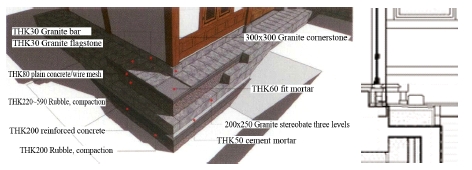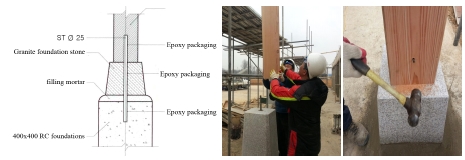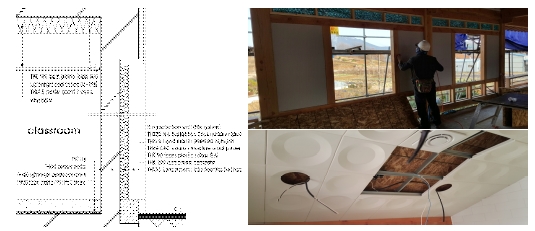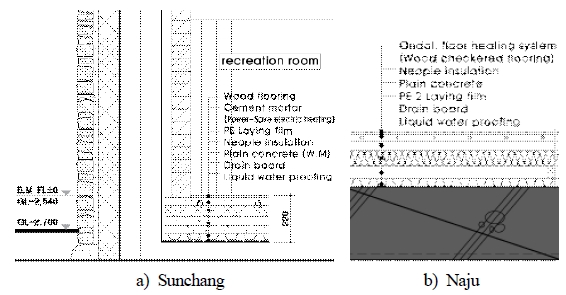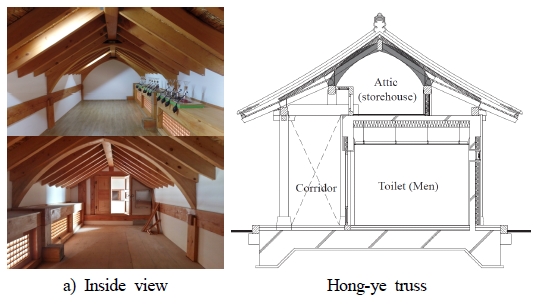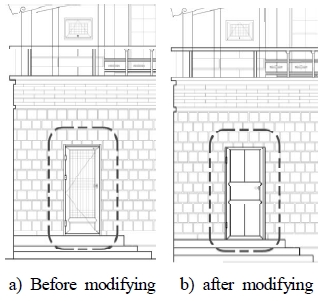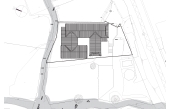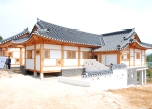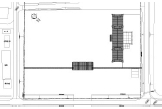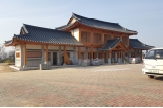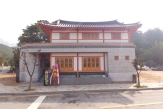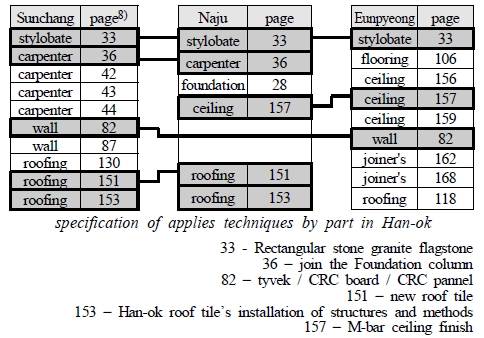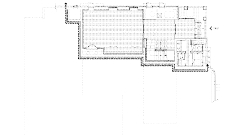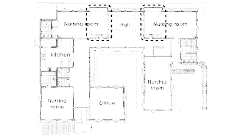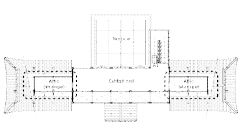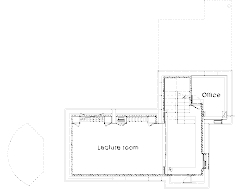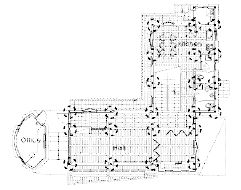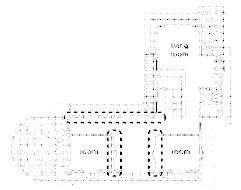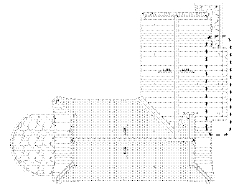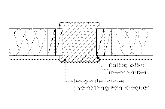
The Application Technology of Korean-style R&D in Verification for deploying the Neo-Korean Style Public Building
- Focused on the positivistic case R&D Technologies in Neo-Korean Style Public building
ⓒCopyright Korea Institute of Ecological Architecture and Environment
Abstract
This study, by comprehensively the characteristics of new Hanok application techniques with the proposed site application technology in the course of the design changes that have been accumulated through Hanok technology development the second stage business, by analyzing the range of reflection, new Considering the direction reflects the efficiency of the new Hanok application techniques.
new Hanok application technology, it was been established through research and development of large 1 new Hanok technology it has been proposed through the “site-specific application techniques” and 2 builders and designers “space-time proposed technique”Analysis of the case, at the center of the design changes, the land the body of laws and regulations, the requirements of the public buildings, compared to the construction method and the like for the reduction of construction costs, new Hanok applied technology in the process of change by it There was analyzed whether acceleration on the range and step which is reflected in the design
The result of new Hanok applied technology was built through the demonstration build business case, process another major technology, foundation, woodwork, walls, roof, has been reflected in the ceiling construction, the inclusion of items in the proposed technique of construction , it was applied to the main steps in general, except for other construction work landscaping. Application techniques and construction proposal technology research team has presented, show the difference between the scope and method. With significance effort to improve the unreasonable traditional methods of these core processes that can be reflected in the field repeated the construction proposed technique as a result of the utility that can be applied for substantial construction.
Keywords:
New-Hanok Type, Neo-Korean Style Public Building, Applied Techniques by part in Hanok키워드:
신한옥, 신한옥형 공공건축물, 신한옥 R&D 기술1. Introduction
1.1. Background and purpose of study
The Han-ok promotion project of public buildings has been extended to the general public through years of government support and publicity. In addition, architectural attempts for the popularization of Han-ok, verification of practicality, more realistic technology improvement, etc. have been made. The Han-ok technology development study has continued to analyze the structural limitations faced by traditional Han-ok and provide alternatives to solve architectural problems.
The first stage of Han-ok technology development study conducted under this background was a stage to build reliability in terms of improvement of construction performance and cost reduction by combining traditional construction technology and building materials with new technology, and it was possible to develop into demonstration construction project that applied the result of the study of the first stage project to the second stage study. The Han-ok technology development in Phase 2 has progressed to the verification stage and focused on suggesting the limits of technique applied new Han-ok and design improvement measures to ensure continuous competitiveness through the construction of a neo-Korean style public building in three areas of Seoul, Sunchang, and Naju.
The demonstration construction project expanded Han-ok applied technique, which was originally concentrated in Han-ok residential space, to public buildings, and proved the possibility of applying it to the new Han-ok design reflecting the variable characteristics according to the usage and function space requirements.
In this study, the applied technique for each part in the 'demonstration construction project of neo-Korean style public building' which is the second stage of Han-ok technology development, is divided into applied technique of first stage of the new Han-ok type and applied technique suggested in design change process, and in the future, we will examine the efficient reflection direction of the applied technology of neo-Korean style public buildings.
1.2. Scope and Method of Study
The applied technique of new Han-ok is largely divided into two parts: 1. 87 items of “applied techniques by part” established through the study of the first stage of technology development of new Han-ok (2010.10-2013.9) applied techniques by part 'and 2.' construction proposed technique' applied after on-site verification construction method offered through contractors and designers.
The applied technique by part is divided into 100% application technique and supplementary application and exclusion technique depending on the degree of application. Construction proposed technique is divided into architects and contractors proposal technique and field proposal technique
In this study, we intend to compare technical characteristics of Han-ok type applied technique by part of the demonstration construction case such as the Public Daycare Center in Sunchang (completed in April 2016) and the Naju Agricultural Science & Education Center (completed in April 2016), 1)Eunpyeong Han-Ok Village Hall (completed in October 2016), and analyze the limitations of the applied technique and the reflected method
Since various Han-ok application techniques were applied based on the results of the Han-ok technology development study at all three sites although the three buildings of subject cases took different types of facilities, sizes, and construction period, it is meaningful to examine the applied techniques of each site in terms of comparative analysis of the applied techniques of the neo-Korean style public building.
In order to analyze new Han-ok techniques reflected in each site, we refer to the basic design book, the practical design book, the technical proposal of the construction company, and the design consultation data of the study group.
We compared each case with the design changes, such as laws, regulations, public building requirements, construction methods to reduce construction costs, etc., and analyzed the scope of the new Han-ok applied technique reflected in design in the process of change and whether the process is modifiable or not.
Since, in particular, Eunpyeong Village Hall, which was the last construction project, reflected considerable parts of the applied technique of new Han-ok type to the site based on the accumulated technology from the previous two examples, in this paper, we compare and analyze the changing process and characteristics of applied techniques by Eunpyeong Village Hall.
2. New Han-ok type applied technique and demonstration construction of public buildings
2.1. Han-ok technology development R & D2)study overview and status
The Ministry of Land, Infrastructure, and Transport has provided 5 billion won to 33 locations through the “Han-ok Building Support Project” ’3)since 2008 and encouraged them to promote Han-ok public building projects by local governments. Han-ok Technology Development R & D Phase 2 project of the Korea Agency for Infrastructure Technology Advancement (2014.09.30 ~ 2016.10.30.) aims at demonstration construction that can contribute to popularization and dissemination of Han-ok technology and settlement of Han-ok housing culture by Han-ok town development and development of public Han-ok architecture.
Therefore, the three cases constructed as part of the “development and construction of new Han-ok type public building model” (3 details) are the experimental cases that attempted the possibility of the Han-ok as public facilities expanded from the concept of the traditional Han-ok study .
2.2. Construction Background and Design 4)Outline of neo-Korean style public building
The new 'Han-ok style public building', which was established through the previous studies, is to improve the disadvantages of the Han-ok with the introduction of the advanced construction technology together with the historical value of the traditional Han-ok, It means to improve to adapt to life and environment. It has the legal status of 'Han-ok architecture style' in the 「Law on the Promotion of Building Properties such as Han-ok」.
The neo-Korean style public building can be a center for transforming social awareness of existing Han-ok and creating a social foundation by extending the scope of Han-ok to public buildings 5)as well as residence by inheriting the merits of traditional Han-ok.
The three cases built through the demonstration construction project were completed in Sunchang, Naju, and Eungpyeong in order. Public Daycare Center in Sunchang is a new Han-ok type daycare facility located in Bangchuk village, Geumgwa-myeon, Sunchang-gun. which is RC structure of the basement and the wooden structure of the first floor, one basement floor and one ground floor with a building area of 337.92㎡.
Naju Agricultural Experiential Learning Center is a new Han-ok type educational research facility located on the site of Naju Agricultural Technology Institute, which is RC structure on the first floor and the wooden structure of the second floor, the second floor with building area of 374.94 ㎡.
Eunpyeong Village Hall is located in the Han-ok Village, New town, Eunpyeong-gu, Seoul. The basement first floor is RC structure, the first floor is lightweight steel structure, the second floor is wooden structure. It is a community facility with one basement floor and two ground floor It is neighborhood living facilities with a building area of 273.9㎡ and floor area of 68%. (See Table 1)
2.3. Han-ok technology Development New Han-ok applied technique classification and application
The new Han-ok R&D technology aims to improve the current construction method, which is dependent on the skilled worker, and to promote the spread and generalization of Han-ok through overall construction performance improvement and construction cost reduction. The technological items applied to the demonstration construction project consist of 12 processes and 87 detailed technologies.
The design and construction requirements for each process are classified as mandatory (11), optional (16), and additional (60). The applied technique group accounts for 69%, which is mostly applied to residential Han-ok technology, so it is limited to public buildings. In order to overcome the limit of application of these detailed items, we extended various study support so that it can be applied by changing part of the construction method or changing the material according to the characteristics of the application site.
The experimental approach of applying the technology in the demonstration construction stage is very important for expanding the scope of construction limited to the residence and improving the possibility and reliability of large buildings such as public building. Comparing the coverage of each case and the major technologies examined through previous studies, 6)Eunpyeong Han-Ok Village Hall is the most popular with 17 coverage including mandatory application technology, but there are 16 coverage of Sunchang Public Daycare Center, 14 coverage of Naju Agricultural Exhibition Hall Science & Education Center with a total of minor differences. Rather, what should be noted is the technology item that adjusts and changes some of the technology applied in existing study to adjust the reflectivity of the field.
In particular, Eunpyeong Han-Ok Village Hall reflects the most revised application techniques, which is evaluated as a result of complementing the technical problems in the previous two cases. In addition, the exclusion ratio of major process technologies is gradually decreasing, so it is expected that more stable technical support will be expected in the future.
3. Type Analysis of new Han-ok type Applied Techniques by Part7)
3.1. Main new Han-ok Applied Techniques of Han-ok technology development phase 1
New Han-ok applied technique has been studied and developed to overcome the shortcomings of traditional building technology and material performance and to reflect the demands of modern people. Furthermore, securing functionality through combination with modern technology is a way to overcome the limitations of traditional construction methods.
The items of applied techniques by part should take into account the possibility of choosing according to the use of the facility rather than the direct reflection rate. Therefore, the applied techniques differ according to the size and nature of each case.
In the case of the comparative group, the applied technique repeatedly used on the stylobate, the wooden structure, the wall, the ceiling, and the roof has a relatively stable utility value. In the case of Naju site, although the applied technique by part ratio is the lowest, the technology group verified through the Sunchang site is reflected again and it is meaningful as a pilot field for technical support of the following site. The three sites reflected common applied techniques in stylobate, carpentry, wall construction, roof construction, and ceiling area.
1) Stylobate construction - The new Han-ok type stylobate process using pole stone and granite flagstone is an applied technique that reflects all case groups. It is composed of 1 ~ 3 stages using granite, the lower part of the stone is reinforced with masonry compaction and concrete and the upper part is a stylobate finished with granite plate stone.
The height of the stylobate is determined according to the slope of the earth and consists of the eardrum, floor, stylobate stone, stylobate bottom, and cornerstone. The stylobate is usually installed to protect the wood from moisture, rain, and water from the ground. However, the size and height of the stylobate vary depending on the type and size of the building.
2) Carpenter construction - As an applied technique reflected in the case of Sunchang and Naju, which have relatively large building area, the foundation and column connection area are reinforced by inserting steel rods, and the joining parts of each member were made of steel to simplify the cutting and assembly process and to increase the strength of the joint.
3) Wall Construction - Heating and insulation are very important because the nursery and town hall are places where the user is staying for a long time.
Waterproofing Tyvek and non-asbestos fiber-reinforced cement board CRC boards are used to prevent condensation inside the building and a method that can replace existing waterproof gypsum board, bam light, etc. in terms of nonflammability, water resistance, sound insulation and economical efficiency.
4) Roof construction – New Yeowa(tile) 9)developed to improve the disadvantages of existing earthenware and to improve the construction is economical by reducing the transportation and construction labor cost through light weight technology, and it is also superior in heat insulation and can be applied both wet and dry construction. Above all, it was modified to prevent the damage of wood corrosion caused by leakage.
Han-ok tile installation structure and method 10)is used lightweight Korean-style grilled tile adopting dry type construction method in order to improve the disadvantages of the wet type construction of the traditional tile connection,
In other words, it is new Han-ok application technique that reduces the roof load by naturally eliminating soil and reduces the construction cost by 20 ~ 25% due to reduction of material cost, labor cost and construction period shortage.
Eunpyeong Village Hall is not reflected because only Korean style tile can be constructed according to Han-ok village ordinance.11)
5) Ceiling construction - The construction of ceiling is applied in such a way that ceiling joist is constructed using lightweight studs according to the conditions and applications of the exposed upper structure, the lower part is closed with double gypsum board and the insulation material is not installed. Depending on the condition of the roof top structure, the gypsum board may be finished using a joist without separately building ceiling joist
In the case of a space for separate work, stud ceiling was installed for lighting equipment installation and electrical wiring management efficiency.
3.2. Compensation and Modification of 1st stage technology of Han-ok technology development
The target cases follow the plane composition suitable for the type of the facility, but the main space of the traditional Han-ok is borrowed and planned as a public space, suggesting the modern utilization direction of Han-ok. However, applied techniques by part optimized for residential Han-ok design require complementation and modification.
The proportion of complementary application techniques was highest in Sunchang Public Daycare Center. Especially, many supplementary application technologies were reflected in the wall and roof construction. Especially, it was improved by applying some of the finishing materials and method of the integrated work among the sacrum membrane process, and roof construction was also changed and modified according to the construction conditions and the finishing materials.
Although the Naju expo is less reflective of the applied technique compared to other cases, it appears similar to Sunchang in terms of application ratio by part. However, while the wall application technology, which simplifies part of the process, is remarkable, the roofing process is marginally higher. The ratio of wall and roof processes of Eunpyeong Residents Center also is also noticeable. It should be noted that most of the complementary application technologies are reflected in the final site, and the progress of the main processes such as wall, floor and roof construction has increased.
Especially at the site of the Eunpyeong Residents Center, alternative construction method of complementary application technology is more concrete. For example, the cornerstone of the woodworking process and the iron gate of bottom of the pillar were changed to the concrete structure and pillar pads when the upper deck plate of the second floor was installed, and the pillar structural building material was replaced by the increase of the construction cost.
3.3. Types and characteristics of proposed technology of Contractor and Study Team
The greatest characteristics of the construction proposed technique are to shorten or simplify the entire construction period including time for material by omitting some processes or reducing the process scope, and to achieve economic benefits resulting in cost savings. However, the construction proposed technique in all cases can not be directly attributed to cost reduction. Nevertheless, it is evaluated as more than economical in that it ensures the construction performance and provides the basis for commercialization.
The construction proposed technique presented through the demonstration project of neo-Korean style public building differs from the existing applied technique. First of all, since the existing applied technique is limited to residential facilities, the range that can actually be used is limited when the size of the building is large or the purpose is different.
On the other hand, after selecting the construction company, construction proposed technique is to adjust the situation and direction of the site in the course of implementing the design phase so that a part of the existing applied technique can be modified or supplemented to fit the facility or adopted completely different method but based on existing Han-ok type the applied technique
Typical construction proposed techniques are summarized into four processes.
The Sunchang Public Daycare Center and the Eunpyeong Residents Center secured insufficient indoor space by creating the underground space, and there is an advantage that the necessary space can be divided functionally in that the modern construction technique can be sufficiently reflected in the noise, the inter-floor height, and the equipment part without obstructing the beauty of Han-ok on the ground floor.
Of course, the cost of construction is inevitably increased, but there is a need for large space that can block noise like a playground in a Han-ok Childcare Center, or it is used as a method to distinguish by room as a limited space for administrative and business related meetings, not for residents' space like basement meeting room of the Han-ok Residents Center
Sunchang Daycare Center built on farmland dug soil of about 5 meters to secure the grounding capacity and the basement part of the R/C structure was constructed by pouring concrete after substitution of soil and compaction. The two buildings were constructed with mat foundation to keep the ground area wide.
Eunpyeong Residents Center constructed the foundation by pouring concrete after crushing about 5.9m, since most of the building area was identified as rock layers during the underground excavation process. It was completed by adjusting the position of the existing house without changing the interior space so that the outer wall of the basement DA space was exposed to the rock as it was.
Since the foundation of wooden structure is a very important structural parameter, the ground foundation design is a very important process directly connected to the ground-layer slab. The basement design, which is preferred in most new Han-ok type constructions, needs to be carefully approached from the air conditioning equipment and structural aspects on the back side, which can be an effective plan for securing the convenience space.
By combining the roof traditional wooden structure with some of Wang Dea-gong truss and Hong-ye truss, the function as structure and the method to utilize roof gable space were suggested. The construction of standardized truss and Hong-ye truss is meaningful as an example of the possibility of spread of new Han-ok.
Geum-gwa Daycare Center in Sunchang, when the roof is made, the space composed of the lantern ceiling like main floored room is constructed with the Korean style roof structure, but the nursery room and chief room, etc. which are finished with the ceiling, by applying diaphragm to the truss structure, are planned not to use soil but to form roof tiles with wood, to finish the plywood above the diaphragm, and to install the above insulation. After the construction, the elevation inside the attic installed reinforced glass between the girders to enhance the safety effect and maintain aesthetics, and the elevation toward the nursery room was composed of wooden louver, and expected the visual effect so that the low space cannot be seen as tightness
Especially, Naju's Agricultural Education and Experience Center was applied the Hong-ye truss (Arch truss) structure, which is construction proposed technique, to secure the roof space of both buildings. In the initial design, the upper structure designed as a massive arch was replaced with Hong-ye truss (Arch truss) and as an alternative technique to solve the structural problem while securing the roof space, was first applied to the neo-Korean style public building as applied technique proposed by the constructor.
Hong-ye truss goes through the process of constructing the grooves in the middle, making the grooves, raising the grooves and reinforcing with the steel joints. The roof of the Hong-ye truss section was exposed and finished using the structural wooden rafters instead of Wonju rafters and OSB structural plywoods instead of canopy.
The Eunpyeong Residents Center contacted the regulations on the structure of the Han-ok (Article 14) and the second floor Han-ok (Article 21), so the upper floor structure retained the traditional Korean-style wooden structure and the first floor and second floor were separated and distinguished between floors in an appropriate manner.
The steel-frame wooden structure method first applied at Eunpyeong Residents Center, as technique applied to the entire first floor, is the method that H-shaped steel (300x50x6) is installed at the column position, the surface is finished with the designated wood after the inside of the steel is filled with the designated wood. These steel-frame pillars are divided into glass wool filling type and edge construction type depending on the type of joint, and they are classified as type of connection construction part between foundation stone, outer wall and wooden pillar.
It was carried out structural review on steel structure and composite beam of the first floor and the basement floor structure was formed so that the beams beneath the pillars pass through to prevent the structural defects that cause punching when the wooden pillars are installed on the upper slab of the basement floor.
The steel structure and the wood finishing method are apparently not much different from the wooden structure, and the material supply is reduced by about 70% compared to the woodworking method.
In addition, it has various applications such as inserting the interior auxiliary illumination according to the closing method of the wood board on the surface of the steel.
Traditional Korean windows of Han-ok are the most suitable design elements to express traditional aesthetics, but there is a lot of room to complement convenience and practicality in terms of the equipment directly connected to heating and cooling. The system window developed with new Han-ok type applied technique is a product considering both the efficient aspect of the window and the traditional aesthetics.
Since, especially, since the Eunpyeong Resident Center constitutes the most similar space conditions to the residential environment compared to the Sunchang and Naju sites, all opening and closing windows facing outside are considered for insulation and soundproofing by installing double windows or using system window. The interior and exterior timbers of the window are made of natural vegetable lacquer stain, all doors are provided with anti-fingers prevention, and glass and acrylic are mixed according to the installation location and frequency of use.
The types of windows were selected according to the characteristics of each room, and typically, what was planned spoke door as boiler room window in the design process was changed to wooden wall door. In the future, it is necessary to subdivide the type of Korean style system suitable for the purpose according to the space and it is required to expand and develop the range so that the choice can be made according to durability.
3.4. Analysis of applied techniques by part of neo-Korean style public building
The applied techniques by part reflected in the neo-Korean style public building extended acceptance range with repeating the demonstration building sites and while modifying and supplementing existing technology types, pursued the rationality considering construction performance by site including the site proposal technology.
Considering the reflected aspect of applied technique, slightly increased from first 6 processes in Sunchang site to last 7 processes in Eunpyeong site whereas the case of improvement was totaled to 20 (22%) in Sunchang Public Daycare Center, 11(13%) in Naju Agricultural Science & Education Center and 25 (25%) in Eunpyeong Residents Center, and the number of processes was reduced but the reflection ratio was increased.
Modifications and complementary construction methods in the applied technique are the cases that may require reinforcement in the construction process or may be difficult to verify performance after construction.
In addition, there is no problem in construction, but because it is not economical due to the high cost of materials, it should be noted the applicability of new Han-ok type applied technique as a result of application of the existing materials
The case reflected through the revision and mitigation of the applied technique like this is encouraging enough in that it provides room for acceptance through appropriate action by noting the possibility of field use. In other words, it suggests improvement plan to enhance economic efficiency and application ability by mixing common materials in the applied technique .
Since the construction proposed technique is an applied technique designed most appropriately considering the characteristics of the public buildings and the variables according to the site conditions, it reflects the specificity and efficiency simultaneously. The three case groups constructed as demonstration construction project possess each distinctive construction proposal technology and share the viewpoint of the applied technique along with the existing Han-ok type applied technique.
4. Conclusion
The neo-Korean style public building has a significance in that it has a room to improve the limit of traditional Han-ok which is not suitable for the modern architectural environment through the connection with the modern building technology and identifies its possibility.
As a part of the demonstration construction project of Han-ok Technology Development Research, this study examined the reflection ratio of the applied technique of new Han-ok type and the core technique of the major construction in the whole process in the neo-Korean style public building built in Sunchang, Naju, and Eunpyeong area. The characteristics of these are summarized as follows.
1. The new Han-ok type applied technology reflected to the public buildings accounted for average 38% of the total of the entire process, the applied range was 16.3% in the R&D technology, and 20.3% in the complementary type partially revised and applied according to the site situation.
The fact that the Han-ok type applied technique was reflected most in the last construction site, Eunpyeong Resident Center, means proficiency of construction technology accumulated through repeated site, and the example of complementary application of original technology can also be understood as an improvement of technology.
2. Among the applied techniques of the new Han-ok type of three cases constructed through the demonstration project, the main technologies of each process were reflected in the stylobate, woodwork, wall, roof, and ceiling works, and if the construction proposed technique item is included, it can be considered that it was applied to all the main processes except for landscape and other works.
3. Applied technique presented by the study group and construction proposed technique show differences in scope and method. It is suitable for the use of the facility, and as a result of actual construction, the construction proposed technique is reflected according to each site. They are meaningful as a result of efforts to improve the unreasonable traditional method of core processes and to expand the scope of existing applied techniques and strengthen their expertise.
Public facilities are public infrastructure that provide everyday places to citizens and are representative social infrastructures that respond to the demands of the times. Applying the new Han-ok type building to the public facilities can be the most effective practical help for the activation of Han-ok. In this regard, studies should be continued in order to harmonize with modern technology in a more active manner, away from institutional and structural problems, and if the new Han-ok R & D demonstration construction project play a central role in spreading Han-ok culture, it is necessary to actively support the improvement of the government-level system and even the development of software programs suitable for the new Han-ok construction development
Acknowledgments
This study is part of the results of the 2014 grant support by Korea Agency for Infrastructure Technology Advancement. Assignment number: 14AUDP-B070934-02
The Application Technology of Korean-style R&D in Verification for deploying the Neo-Korean Style Public Building - KIEAE Journal : Vol.15 No.5(통권 75호) 2015. 10
References
- Kim, Y.H., (2015), The Application Technology of Korean-style R&D in Verification for deploying the Neo-Korean Style Public Building, Journal of Architectural Institute of Korea’s ecology, 15(5), (2015).
- Kim, Y.H, (2016), Application of the Public Buildings for the Korean-style houses in the availability of R&D technologies, Journal of Architectural Institute of Korea’s ecology, 16(3), (2016).
- Park, J.Y., (2015), The Design Elements for the Model Development of New-Han-ok Type Service Facilities in Apartment Housing, Journal of Architectural Institute of Korea ’ s ecology, 15(3), (2015).
- Peck, Y.J., (2016), Research on the Design Trends and Spatial Components of Han-Ok Public Daycare Center, Journal of Architectural Institute of Korea’s ecology, 16(4), (2016).

